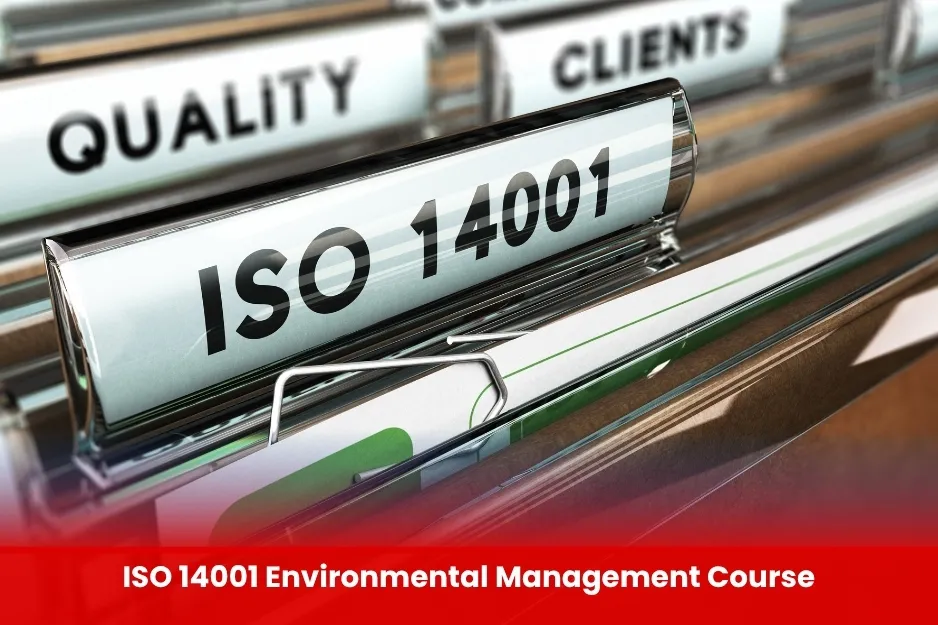ISO 14001 Environmental Management Course
ISO 14001 is the internationally recognized standard for developing and implementing an Environmental Management System (EMS). It provides a structured framework that organizations of all sizes and sectors can use to systematically manage their environmental responsibilities and improve environmental performance.
The ISO 14001 standard helps organizations minimize their environmental footprint, comply with applicable laws and regulations, and achieve continual improvement in sustainability practices. It addresses key areas such as resource use, waste reduction, pollution control, and life-cycle thinking, all while aligning with strategic business goals.

Aim of ISO 14001 Environmental Management System
The aim of ISO 14001 is to provide organizations with a systematic framework to identify, manage, monitor, and continually improve their environmental performance in a way that is sustainable, efficient, and compliant with regulatory and stakeholder expectations.
Course Overview
ISO 14001 Environmental Management Course
For Organizations Seeking ISO 14001 Certification:
ISO 14001 is applicable to any organization, regardless of:
- Size (small, medium, or large enterprises)
- Type (public, private, or non-profit)
- Sector (manufacturing, services, construction, logistics, etc.)
To be eligible for certification, an organization must:
- Have operations or processes that interact with the environment
- Be committed to complying with environmental regulations and improving environmental performance
- Be able to implement and maintain an Environmental Management System aligned with ISO 14001 requirements
- Undergo a formal audit by an accredited certification body
| Course Code | Curriculum Title | Credit | DLH |
|---|---|---|---|
| BUK1931-1 | Introduction to ISO 14001 & Environmental Management | 3 | 20 |
| BUK1931-2 | Structure of ISO 14001:2015 Standard | 3 | 20 |
| BUK1931-3 | Environmental Aspects and Impacts | 3 | 20 |
| BUK1931-4 | Legal and Other Requirements | 3 | 20 |
| BUK1931-5 | Objectives, Targets & Environmental Planning | 3 | 20 |
| BUK1931-6 | Implementation & Operation of EMS | 3 | 20 |
Module 1: Introduction to ISO 14001 & Environmental Management
- What is an Environmental Management System (EMS)?
- Overview of ISO 14000 family of standards
- Purpose, structure, and benefits of ISO 14001
- Key environmental challenges and global context
Module 2: Structure of ISO 14001:2015 Standard
- High-Level Structure (HLS) of ISO management systems
- Clause-by-clause overview of ISO 14001:2015:
- Context of the Organization
- Leadership
- Planning
- Support
- Operation
- Performance Evaluation
- Improvement
Module 3: Environmental Aspects and Impacts
- Identifying and evaluating environmental aspects
- Determining significant impacts
- Life cycle perspective in EMS
- Operational controls and mitigation
Module 4: Legal and Other Requirements
- Identifying applicable environmental laws and regulations
- Compliance obligations
- Monitoring and evaluation of compliance
- Maintaining a legal register
Module 5: Objectives, Targets & Environmental Planning
- Setting SMART environmental objectives
- Developing environmental programs and action plans
- Planning for risk and opportunity management
Module 6: Implementation & Operation of EMS
- Roles, responsibilities, and resources
- Competence, awareness, and training
- Internal and external communication
- Documentation and control of information
- Emergency preparedness and response
Module 7: Monitoring, Measurement & Evaluation
- Environmental performance indicators
- Internal audits (ISO 19011 guidelines)
- Nonconformance, corrective and preventive actions
- Continual improvement
Module 8: Internal Auditing (for Auditor Courses)
- Principles and types of audits
- Planning and preparing for audits
- Conducting interviews and collecting evidence
- Writing nonconformity reports and audit findings
Module 9: Certification Process
- Steps to ISO 14001 certification
- Choosing a certification body
- Pre-assessments and formal audits
- Maintaining certification and surveillance audits
Environmental Managers & Officers
Health, Safety & Environment (HSE) Professionals
Quality Management Professionals
Sustainability and ESG Coordinators
Engineers and Operational Managers
Consultants and Auditors
- All Modules within this qualification are assessed internally by the approved training Centre and externally verified by BURRAQ UK. The program uses a criterion-referenced assessment approach to ensure that learners successfully meet all required learning outcomes.
- A Pass in any unit is granted only when the learner submits valid, reliable, and authentic evidence that demonstrates achievement of the assessment criteria. The Assessor is responsible for reviewing this evidence and confirming that the learner has attained the expected standard.
